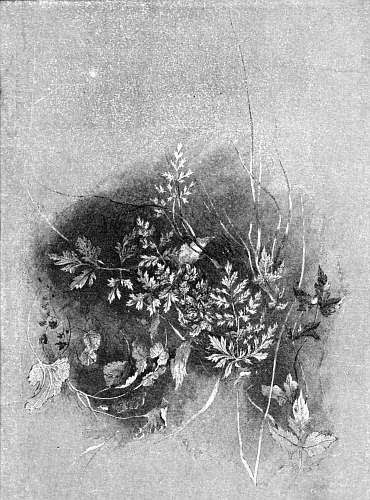6. Foreground Leafage.
§ 17. How far Turner followed it, is not easily shown; for his finish is so
delicate as to be nearly uncopiable. I have just said it was not possible to
finish that ash trunk of his, farther, on such a scale.By using a magnifying-glass, and giving the same help to the spectator, it might
perhaps be possible to add and exhibit a few more details; but even as it is, I
cannot by line engraving express all that there is in that piece of tree-trunk,
on the same scale. I have therefore magnified the upper part of it in fig
4. (Plate 5.), so that the reader may better see the beautiful lines of
curvature into which even its slightest shades and spots are cast. Every quarter
of an inch in Turner's drawings will bear magnifying in the same way; much of
the finer work in them can hardly be traced, except by the keenest sight, until
it is magnified. In his painting of Ivy Bridge, the veins are drawn on the wings of a butterfly, not above three lines in
diameter; and in one of his smaller drawings of Scarborough, in my own
possession, the muscle-shells on the beach are rounded, and some shown as shut,
some as open, though none are as large as one of the letters of this type; and
yet this is the man who was thought to belong to the "dashing" school, literally
because most people had not patience or delicacy of sight enough to trace his
endless detail. wholesale oil paintings§ 18. "Suppose it was so," perhaps the reader replies; "still I do not like detail so delicate that it can hardly be seen." Then you like nothing in Nature (for you will find she always carries her detail too far to be traced). This point, however, we shall examine hereafter; it is not the question now whether we like finish or not; our only inquiry here is, what finish means; and I trust the reader is beginning to be satisfied that it does indeed mean nothing but consummate and accumulated truth, and that our old monotonous test must still serve us here as elsewhere. And it will become us to consider seri ously why (if indeed it be so) we dislike this kind of finish—dislike an accumulation of truth. For assuredly all authority is against us, and no truly great man can be named in the arts—but it is that of one who finished to his utmost. Take Leonardo,oil paintings wholesale, Michael Angelo, and Raphael for a triad, to begin with. Theyall completed their detail with such subtlety of touch and gradation, that, in a careful drawing by any of the three, you cannot see where the pencil ceased to touch the paper; the stroke of it is so tender, that, when you look close to the drawing you can see nothing; you only see the effect of it a little way back! Thus tender in execution,—and so complete in detail, that Leonardo must needs draw every several vein in the little agates and pebbles of the gravel under the feet of the St. Anne in the Louvre. Take a quartett after the triad—Titian, Tintoret, Bellini, and Veronese. Examine the vine-leaves of the Bacchus and Ariadne, (Titian's) in the National Gallery; examine the borage blossoms, painted petal by petal, though lying loose on the table, in Titian's Supper at Emmaus, in the Louvre, or the snail-shells on the ground in his Entombment; examine the separately designed patterns on every drapery of Veronese, in his Marriage in Cana; go to Venice and see how Tintoret paints the strips of black bark on the birch trunk that sustains the platform in his Adoration of the Magi: how Bellini fills the rents of his ruined walls with the most exquisite clusters of the erba della Madonna. You will find them all in a tale. Take a quintett after the quartett—Francia, Angelico, Durer, Hemling, Perugino,—and still the witness is one, still the same striving in all to such utmost perfection as their knowledge and hand could reach. oil paintings of italy
Who shall gainsay these men? Above all, who shall gainsay them when they and Nature say precisely the same thing? For where does Nature pause in her finishing—that finishing which consists not in the smoothing of surface, but the filling of space, and the multiplication of life and thought?
Who shall gainsay them? I, for one, dare not; but accept their teaching, with Nature's, in all humbleness.
123
"But is there, then, no good in any work which does not pretend to perfectness? Is there no saving clause from this terrible requirement of completion? And if there be none, what is the meaning of all you have said elsewhere about rudeness as the glory of Gothic work, and, even a few pages back, about the danger of finishing, for our modern workmen?"
Indeed there are many saving clauses, and there is much good in imperfect work. But we had better cast the consideration of these drawbacks and exceptions into another chapter, and close this one, without obscuring, in any wise, our broad conclusion that "finishing" means in art simply "telling more truth;" and that whatever we have in any sort begun wisely, it is good to finish thoroughly. oil paintings of flowers

No comments:
Post a Comment